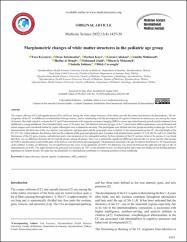Morphometric changes of white matter structures in the pediatric age group

Göster/
Erişim
info:eu-repo/semantics/openAccessTarih
2022Yazar
Koyuncu, EsraTuramanlar, Ozan
Kaya, Furkan
Çalışkan, Gizem
Mahmoud, Camila
Al Bouab, Haifaa
Mohamed, Hozayfa
Jabbary, Soheila
Çavuşoğlu, Dilek
Üst veri
Tüm öğe kaydını gösterKünye
Koyuncu, E., Turamanlar, O., Kaya, F., Caliskan, G., Mahmoud, J., Al Bouab, H., ... & Cavusoglu, D. (2022). Morphometric changes of white matter structures in the pediatric age group. Medicine, 11(4), 1425-30.Özet
The corpus callosum (CC) and capsula interna (CI), which are among the white matter structures of the brain, provide the connection between the hemispheres. The de- velopment of the CC in childhood, its relationship with age and sex, and its relationship with the development of cognitive functions in adolescence are among the issues of interest. Our study aimed to evaluate the CC and CI measurements with magnetic resonance imaging (MRI) to assess age-related normal growth and development from childhood to young adulthood. Three hundred thirty cases (170 males and 160 females) between the ages of 0-15 whose brain MRI examinations were performed and whose images were considered normal by expert radiologists were evaluated in our study. The participants were divided into four groups according to their age. For the CI measurements, the thickness of the crus anterior, crus posterior, and genu parts and the genu angle were evaluated. In the measurements on the CC, the total length of the CC (CC VI), which indicates the distance between the endpoint of the genu and splenium part, was taken with measurements number CC I, II, III, IV, and V, in which the thicknesses of the CC genu, truncus, and splenium parts were measured on the midsagittal section. In the evaluation of the CC sections between the groups, it was found that there was no difference between the 3rd and 4th groups among all groups, there was a statistically significant difference between the 1st group and the other groups (p<0.001), and the anterior and middle parts of the truncus were the earliest developing parts. All parameters increased with age. Except for the thicker CC IV measurement of the isthmus in males, no difference was revealed between the sexes in any parameter (p>0.05). No difference was observed between the right and left sides in the CI measurements (p>0.05). The angle formed in the genu part was found to be 119°. In the literature review, we observed that there were few studies on the healthy pediatric population in Turkish society. We hope that the parameters we obtained may contribute to evaluating potential clinical conditions.















